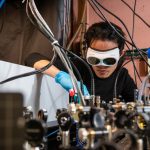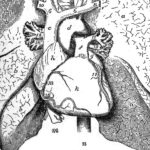
New breathalyser for disease sniffs out COVID in real-time

A new breathalyser for disease can detect COVID in real-time, and could also be used to detect cancer and lung disease
The quantum laser-based technology is a big step forward toward using exhaled breath to diagnose diseases such as covid.
With each breath, humans exhale more than 1,000 distinct molecules, producing a unique chemical fingerprint or ‘breathprint’ rich with clues about what’s going on inside the body.
For decades, scientists have sought to harness that information, turning to dogs, rats and even bees to literally sniff out cancer, diabetes, tuberculosis and more.
Scientists from CU Boulder and the National Institute of Standards and Technology (NIST) have made an important leap forward in the quest to diagnose disease using exhaled breath, reporting that a new laser-based breathalyser powered by artificial intelligence (AI) can detect Covid-19 in real-time with excellent accuracy.
First author Qizhong Liang, a PhD candidate in JILA and the Department of Physics at CU Boulder, said: “Our results demonstrate the promise of breath analysis as an alternative, rapid, non-invasive test for Covid-19 and highlight its remarkable potential for diagnosing diverse conditions and disease states.” JILA is a partnership between CU Boulder and NIST.
The multidisciplinary team of physicists, biochemists and biologists is now shifting its focus to a wide range of other diseases in hopes that the ‘frequency comb breathalyser’ – born of Nobel Prize-winning technology from CU – could revolutionise medical diagnostics.
Senior author Jun Ye, a JILA fellow and adjoint professor of physics at CU Boulder, said: “There is a real, foreseeable future in which you could go to the doctor and have your breath measured along with your height and weight.
“Or you could blow into a mouthpiece integrated into your phone and get information about your health in real-time.
“The potential is endless.”
- Breakthrough for sweat with new wearable health monitoring device
- New device detects brain tumours using urine
- Sensing device explores neurodegenerative diseases
- New model detects long Covid effects without need for CT scans
A Covid-born collaboration
As far back as 2008, Ye’s lab reported that a technique called frequency comb spectroscopy – essentially using laser light to distinguish one molecule from another – could potentially identify biomarkers of disease in human breath.
The technology lacked sensitivity and, more importantly, the capability to link specific molecules to disease states, so they never tested it for diagnosing illness.
But Ye’s team has since improved the sensitivity a thousandfold, enabling detection of trace molecules at the parts-per-trillion level. They’ve also harnessed the power of AI.
Liang said: “Molecules increase or decrease in concentrations when associated with specific health conditions.
“Machine learning analyses this information, identifies patterns and develops criteria we can use to predict a diagnosis.”
With SARS-CoV-2 ripping across the country and frustration mounting about long response times for existing tests, the time had come to test the system on people.
As a physicist, Ye had never worked with human subjects, so he enlisted help from CU’s BioFrontiers Institute, an interdisciplinary hub for biomedical research which was heading up the campus Covid testing programme.
Between May 2021 and January 2022, the research team collected breath samples from 170 CU Boulder students who had, in the previous 48 hours, taken a polymerase chain reaction (PCR) test, either by submitting a saliva or a nasal sample.
Half had tested positive, half negative. Overall, the process took less than one hour from collection to result.
When compared to PCR, the gold standard Covid test, breathalyser results matched 85% of the time. For medical diagnostics, accuracy of 80% or greater is considered ‘excellent’.
The researchers suspect that the accuracy would likely have been higher if the breath and saliva/ nasal swab samples were collected at the same time.
Unlike a nasal swab, the breathalyser is non-invasive. And unlike a saliva sample, users are not asked to refrain from eating, drinking or smoking before using it.
It doesn’t require costly chemicals to break down the sample and the new test could, conceivably, be used on individuals who are not conscious.
But there is still much to be learned – Ye said: “With one breath, we can collect so many data points from you, but then what? We only understand how a few molecules correlate with specific conditions.”
Building a smaller breathalyser
Today, the ‘breathalyser’ consists of a complex array of lasers and mirrors about the size of a banquet table.
A breath sample is piped in through a tube as lasers fire invisible mid-infrared light at it at thousands of different frequencies.
Dozens of tiny mirrors bounce the light back and forth through the molecules so many times that in the end, the light travels about 1.5 miles.
Because each kind of molecule absorbs light differently, breath samples with a different molecular make-up cast distinct shadows.
The machine can distinguish between those different shadows or absorption patterns, boiling millions of data points down to – in the case of Covid – a simple positive or negative, in a matter of seconds.
Efforts are already underway to miniaturize such systems to a chip scale, allowing for what Liang imagines as “real-time, self-health monitoring on the go”. But the potential does not end there.
Molecular biologist Leslie Leinwand, chief scientific officer for BioFrontiers and a co-author on the study, said: “What if you could find a signature in breath that could detect pancreatic cancer before you were even symptomatic? That would be the home run.”
Elsewhere, scientists are working to develop a Human Breath Atlas, which maps each molecule in the human exhale and correlates them with health outcomes. Liang hopes to contribute to such efforts with a larger-scale collection of breath samples.
The results were published April 5 in the Journal of Breath Research.
Image: Qizhong Liang, a PhD candidate in JILA and the Department of Physics at the University of Colorado Boulder, demonstrates how the laser-based breathalyser works, in the Ye lab at JILA. Ultimately, the system could be miniaturised for ‘on-the-go health monitoring’. Credit: Patrick Campbell/ CU Boulder.















